Why Is My Homemade Yogurt Slimy?
Sneak Preview: Find out the cause of your slimy yogurt, how to avoid it in the future, whether it’s safe to eat, and more.
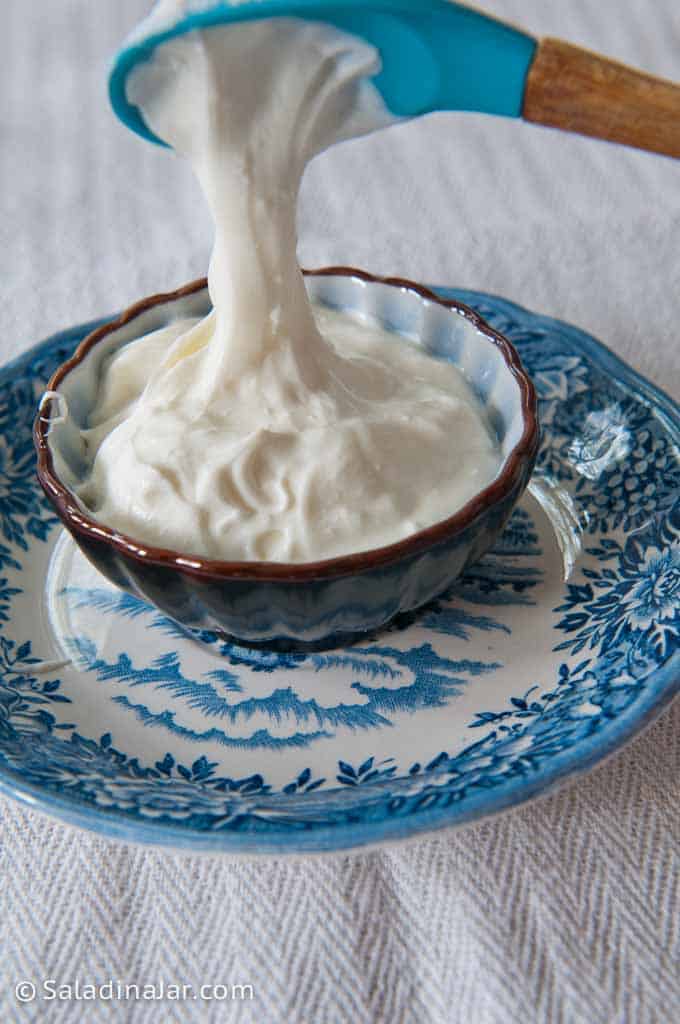
As an Amazon Associate, I earn from qualifying purchases.
Have you ever unintentionally made a batch of stringy or slimy homemade yogurt? The last time this happened to me (see the picture below), I went full crazy to determine what went wrong.
Sharing that yogurt would have ruined my reputation for sure. So please keep reading to find out what I did with it.
Happy Cooks Speak Up
“Thanks for the great site. I came here because I made my usual yogurt with 1 liter of UTH milk plus 1/2 cup of milk powder. Came out stringy and slimy, but the taste is fine. Now I understand why.”
—KM
What Happened To My Yogurt?
Some call their strange yogurt ropey, gluey, stretchy, stringy, or sticky. Others describe it as the texture of honey. Either way, it’s probably not the yogurt you hoped for after going to the trouble to make it.
When troubleshooting yogurt, definitive answers can be hard to pin down. The variations in milk, starters, heating techniques, incubation methods, and a million other details are innumerable.
But let’s give this one a shot.
By the end of this post, you should have some answers to your questions:
Why Is My Homemade Yogurt Slimy?
In two words: Wild Yeast!
1. Wild yeast flies around in the air at everybody’s house.
When it lands in your yogurt, it can mess with the delicate balance among the bacteria. Consequently, slimy yogurt becomes a possibility.
2. Starter from stringy yogurt
Any starter originating from a stringy batch of yogurt produces more of the same. At least that’s my experience. See the pictures below.
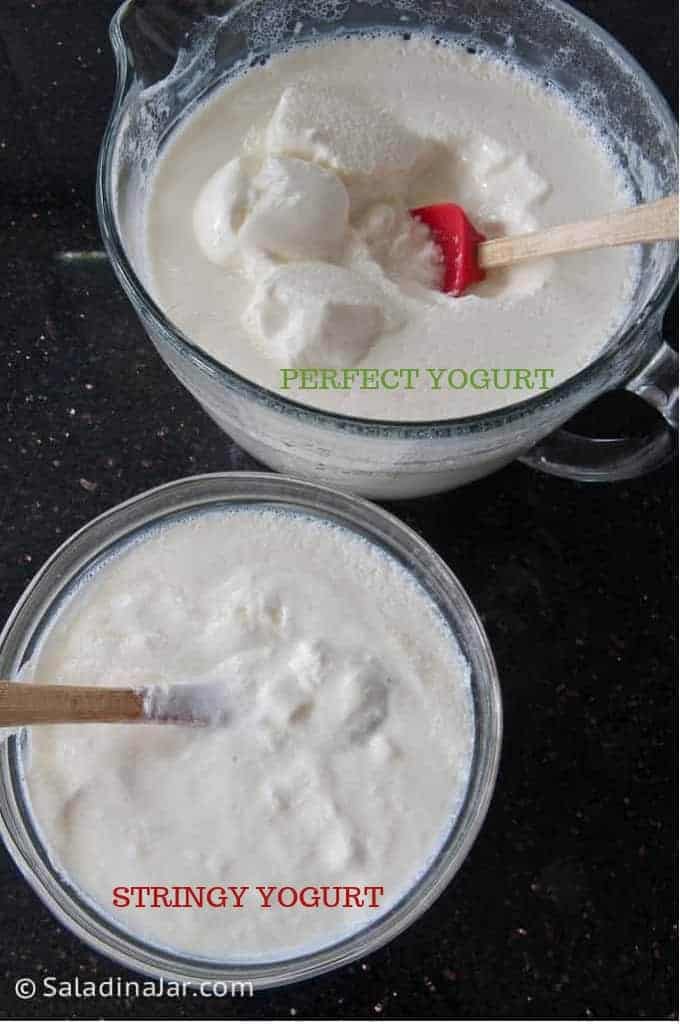
Both of these bowls of yogurt contain the same brand of milk. They were processed exactly alike and incubated similarly for the same amount of time. The only difference? The stringy yogurt was made with a stringy starter. The perfect yogurt was produced with fresh yogurt purchased from the grocery store.
How do I keep wild yeast out of my yogurt? We will get to that, but let’s talk about the starter first. How your yogurt reacts to wild yeast is affected by your starter.
RELATED POST: How To Make Healthy Homemade Yogurt
Does It Matter What Kind of Starter I Use?
Most people use one of two kinds of starters to make yogurt at home:
- Fresh, unflavored yogurt you buy from the store
- “Traditional” or heirloom yogurt starters
What’s the difference?
Fresh yogurt from the supermarket vs. traditional yogurt
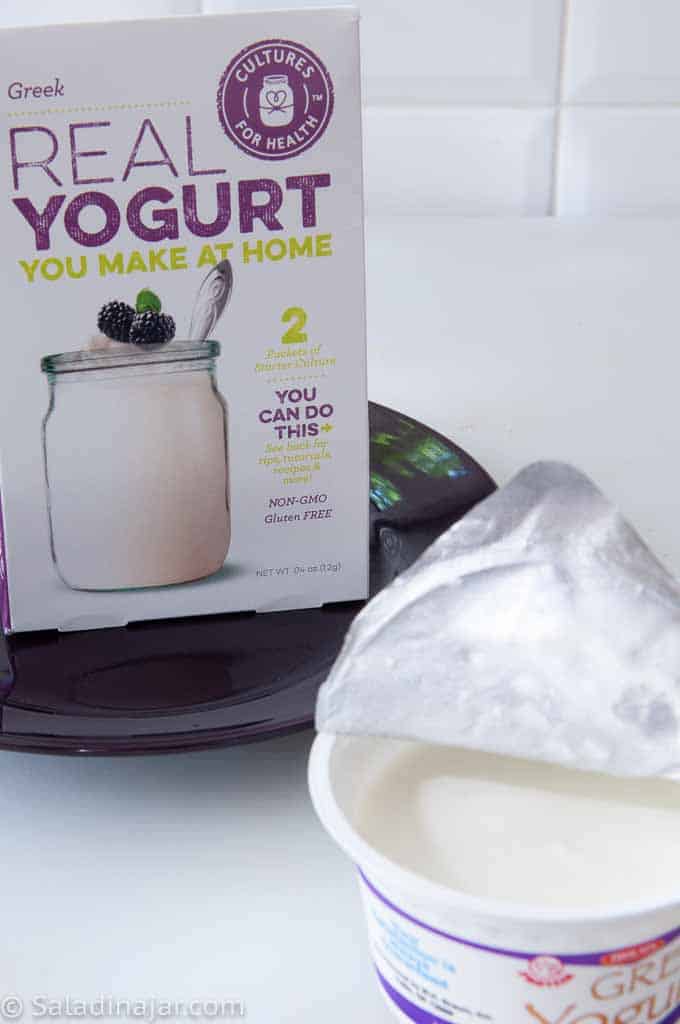
Supermarket yogurt as a starter
Have you ever heard this statement? “Once you buy yogurt from the grocery store, you’ll never need to purchase store-bought yogurt again.”
Not true, unless you are lucky.
Here’s why.
Supermarket yogurt is formulated to produce perfect yogurt in mass quantities.
When you look at the label, only one, two, or sometimes three specific kinds of bacteria are listed.
You could say supermarket yogurt is “hothouse” yogurt. But, like hothouse tomato plants, the yogurt babies incubate in a balanced and protected environment.
Your proposed yogurt project is vulnerable to contamination once exposed to the real world (your kitchen). Wild yeast can upset the perfect environment of a supermarket yogurt starter.
Traditional yogurt starter
Heirloom or “traditional” yogurt starters were initially passed down from one generation to the next. Thus, it is “real-world-yogurt.” The yogurt babies are more varied. The result is a more resilient starter.
“The difference with a traditional starter is that it is composed of more varied bacteria so that when one strain falls prey to phages (a virus that infects and replicates within bacteria), there will be others to take over and maintain fermentation.”
Sandor Ellix Katz from The Art of Fermentation(paid link)
Let’s try another comparison. When a few obnoxious guests (wild yeast) crash a large party (inoculated milk), they won’t upset the balance in the same way as one uninvited guest at an intimate dinner.
“Does this mean I should only use a starter from traditional yogurt?”
Not necessarily. It depends on how often you make yogurt.
Keep reading to decide which starter is best for you.
Don’t be misled.
Slimy yogurt can happen to any of us despite our best efforts.
RELATED POST: Why is my homemade yogurt grainy?
Five Ways To Keep Wild Yeast Out of Your Yogurt
(It’s not always possible. But you can try.)
1. Don’t try to make yogurt using a “starter” from a ropey batch.
The new yogurt won’t get better. It will still be slimy, like the starter used to make it.
The moral of the story?
When you inadvertently make a gooey batch, you must start over with a brand-new starter the next time you make yogurt. (Keep reading to find out if it’s safe to eat the slimy batch.)
2. Be sure all utensils are clean.
In my opinion and experience, you don’t have to sterilize your equipment. Clean? Yes. I run everything through the dishwasher.
“But generally sterilization is unnecessary. Incidental microorganisms that inevitably are found in non-sterile though clean environments cannot generally gain a foothold in a fermentation substrate. This is because the ferment either has its own indigenous microbiota (as in sauerkraut and traditional wines), or has had a critical mass of cultures introduced (as in yogurt, tempeh, and most contemporary beers). We are living in a microbial world, and these processes all developed under decidedly non-sterile conditions.
Traditional mixed culture starters tend to be stable under favorable conditions. Only in the realm of propagating pure-culture mold spores, which tend to pick up more bacterial strains with each successive generation, have I found sanitization beyond mere cleanliness to be warranted.”
Sandor Katz from The Art of Fermentation
3. Some say, “Don’t bake yeast bread the same day you make yogurt.”
I cannot verify this idea from personal experience. So I’m just throwing it out there for what it’s worth.
“One should avoid baking yeast-based bread (including sourdoughs) on the day you make yogurt to avoid cross-contamination.”
Jenny McGruther at Nourished Kitchen (paid link)
Here’s a different opinion.
Sandor Katz, the author of The Art of Fermentation, relates a conversation he had with Betty Stechmeyer, who co-founded a starter culture business, GEM Cultures. She reported that after 30 years of propagating several different sourdoughs, several different milk cultures, tempeh starter, and more in a 12-foot-by-12-foot kitchen, “she never experienced cross-contamination.” He goes on to say, “I cannot guarantee that cross-contamination among cultures is impossible, but it is not a likely occurrence, and I encourage enthusiastic experimentalists to ferment to your heart’s content without worry of cross-contamination.”
4. After 3 or 4 batches, buy new yogurt from the supermarket for a starter.
In a nutshell, the more times you recycle your supermarket starter, the more chances for wild yeast contamination.
Some people say to use the mother culture no more than 3 to 4 times. Check out this quote from Anne Mendelson below for another opinion about the subject.
“That said, you can only do this about six to eight times before the acidity balance gets off and a new, fresh culture will be needed.” Mendelson agrees that the risk of failure increases with reuse. There’s no easy rule for determining the number of times you can use the same mother culture, she says. “All you can do is notice when the yogurt seems not to be setting up right, and get a fresh start by getting a fresh starter.”
Anne Mendelson, the author of Milk: The Surprising Story of Milk Through the Ages (paid link)
“But I’ve heard of people using the same starter for years. How is that possible?“
Most likely, they are using a “traditional” or heirloom yogurt starter. (See more below)
You might get lucky with a supermarket yogurt. Some people, including me, have gone months without buying a new starter. I’m just saying the odds for trouble go up.
If you’re willing to take your chances, keep using your homemade yogurt as a starter until you get a bad batch. When that happens, start over with fresh yogurt from the store.
5. Use a “traditional” yogurt starter
You should be able to use a traditional starter for months, if not indefinitely.
But don’t forget about it or ignore it for too long.
The directions that come with a freeze-dried starter say you need to make new yogurt at least once a week.
If you are not a regular yogurt maker, don’t waste money on traditional yogurt starters. Instead, buy your starter from the dairy case at the grocery store and plan to replace it often.
You could also try freezing a small portion of yogurt from a traditional starter. Read about freezing yogurt in Five Things You Should Not Do When Making Yogurt.
Freezing starter buys time during a vacation or slow yogurt-eating period.
RELATED POST: How Much Starter Do You Really Need To Make Yogurt?
4 Things That Probably Don’t Cause Slimy Homemad Yogurt
While looking around the web, I’ve seen many guesses about what causes a slimy batch of yogurt. But, for the record, I don’t think any of these are the reason.
- Heating the milk too fast
- The incubation temperature wasn’t kept high enough
- Used pasteurized or ultra-pasteurized milk
- Yogurt not incubated long enough (see discussion below)
These actions or conditions may have some influence on the outcome of your yogurt. But in my experience and research, they are not the direct cause of honey-textured or gooey yogurt.
You may be wondering…
How Can You Tell Whether Your Yogurt Is Slimy or Just Not Finished Incubating?
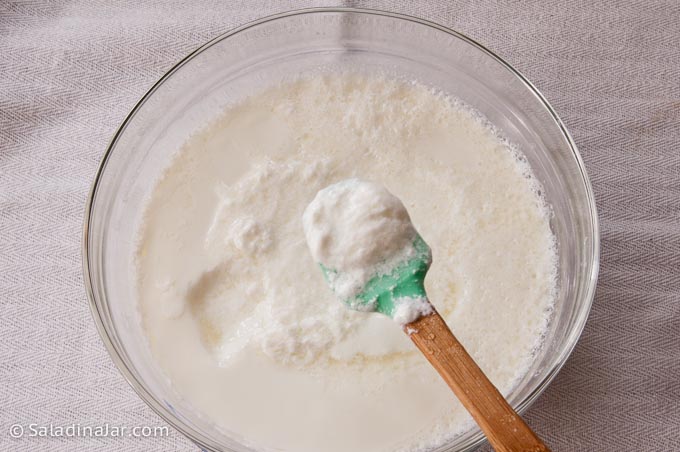
Look at the edges. You can see the yogurt has “set.” It jiggled only slightly–like Jello. However, once I dipped a spatula into the yogurt, the texture is slimy and without form. Compare to the picture below.
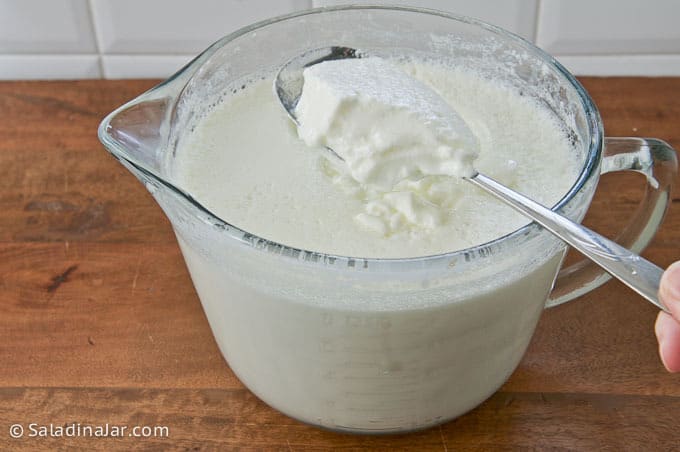
Yogurt should look like this when you dig into it. Set yogurt falls away in sheets or layers.
Is Stringy Yogurt Safe To Eat?
Yes, stringy or slimy homemade yogurt is safe to eat. I’m not the king’s taste tester, but I’ve eaten it several times without consequences.
However, the texture won’t be right, and the taste may be slightly yeasty. It’s not terrible, just not great.
I would compare it to homemade bread that has proofed too long and then falls in the middle when baked. It’s still safe to eat, but the texture and shape are less desirable.
On the other hand, if your slimy yogurt smells terrible, don’t eat it. That rule applies to any yogurt you find in your refrigerator.
Generally, homemade yogurt stays fresh for about two weeks in the refrigerator.
You can find more details about how long yogurt stays fresh on the blog, EatByDate.
Can I Fix Gooey Yogurt?
Unfortunately, no. Or maybe I should say I haven’t figured out how yet.
If you normally strain your yogurt, don’t. It will only make it worse, as you can see in the top picture of this post.
Don’t use it to start more yogurt. Bad idea. The rogue yeasty bodies are probably still alive and will produce more of the same. Use a completely different starter with your next batch,
What Can I Do with Stringy Yogurt?
Now that you know it’s most likely safe, what should you do with it?
You could eat it straight up, but I understand if you would rather not. I didn’t.
- Use it in smoothies.
- Use it in baking things like cornbread, muffins, cake, or similar recipes calling for buttermilk.
Viili Yogurt–Stringy by Design
I have never tried it, but I ran across Viili yogurt in my research. It is ropey and stringy by design.
Who knew? If the idea appeals to you, check out the paragraph below.
Our Viili is a tasty cultured milk product that came from Finland with our family over 100 years ago! As with Fil Mjölk, no special incubators are needed. Just put the starter into a clean bowl, add Pasteurized milk (whole, low-fat, nonfat, half & half or cream), lightly cover and leave at moderate room temperature (65-75 degrees F) for 24-30 hours until it “sets.” That’s all there is to it! The flavor is mild, not tart, and the texture is creamy and honey-like and is eaten with a spoon. Yes, our Viili is the ropey variety!
GEM cultures (paid link)
“Thanks for the great site. I came here because I made my usual yogurt with 1 liter of UTH milk plus 1/2 cup of milk powder. Came out stringy and slimy, but the taste is fine. Now I understand why.”
–KM
Conclusion
There may be other reasons for gooey or stringy yogurt that I haven’t addressed. Nonetheless, my research and experience point to contamination by wild yeast as the primary reason for slimy yogurt.
The easiest way to avoid the problem is to use a “traditional” starter that is less susceptible to wild yeast. If you’re not a regular yogurt maker, use a new batch of yogurt from the grocery store as your starter every three or four batches.
If you have questions or suggestions, email me privately for a quick answer: Paula at saladinajar.com. Hope to see you again soon!



Paula Rhodes, owner
As a retired home economist, I created Saladinajar.com to share my belief that you don’t have to be a chef to find joy in creating homemade food worth sharing. Bread machines (used in an unconventional way), homemade yogurt, and quick microwave recipes are my specialty.